Chapter 5 The Mughal Empire Mughal Empire In India
The founder of the Mughal empire in India was Jahiruddin Mohammad Babur. He defeated the last Sultan of the Sultani empire in India, Ibrahim Lodi. Babur’s father Omar Sheikh Mirza was from the family of a famous Chaghtai Turk.
Taimur Lane and his mother was the daughter of Unish Khan who was from the family of the famous Mongol leader Chengiz Khan.
Historian Sir Stanley Lanepoole said, “The bad blood of Chengiz and Taimur, the two curses of Asia, was mixed with the blood of Babur.” Hence Babur was so strong and brave.
The word ‘Babur’ means tiger or lion. His name is self-explanatory through his activities.
Read and Learn More WBBSE Notes For Class 7 History
Chapter 5 The Mughal Empire Babur 1526 To 1530 A.D
Babur was born on 24th February 1483 A.D. in the Farghana state of Central Asia. His full name was Jahiruddin Mohammad Babur. He became the ruler at the age of 12 only, after the death of his father Omar Sheikh Mirza.
He tried five times from 1496-1512 A.D. to conquer Samarkhand but failed. Babur came to Kabul, the capital of Afghanistan when he was defeated by Farghana leader Shahebani Khan in the battle of Archian in 1503 A.D.

Shahebani made his brother Jahangir Mirza, the king of Farghana. In Kabul, Babur became strong by conquering Kabul and Kandahar and took the title ‘Padshah’ in 1507 A.D.
In the meantime, he captured Samarkand and Taskhand of Central Asia with the help of Persian king Shah Ismail after the death of Shahebani Khan. But Babur. being Sunni Muslim, the conflict with Shah Ismail started became the later was a Shia Muslim.
“The Mughal Empire summary for Class 7 WBBSE”
Taking this advantage, the Uzbeki leaders under the leadership of Ubaid Ullah Khan, defeated Babur miserably in the ‘Battle of Gajdawan’ (1512 A.D.). Babur then came back to Kabul and decided to advance towards India.
The political instability, weakness of the Lodi Sultans, huge wealth and treasures and the success of Taimur Lane inspired him to invade India.
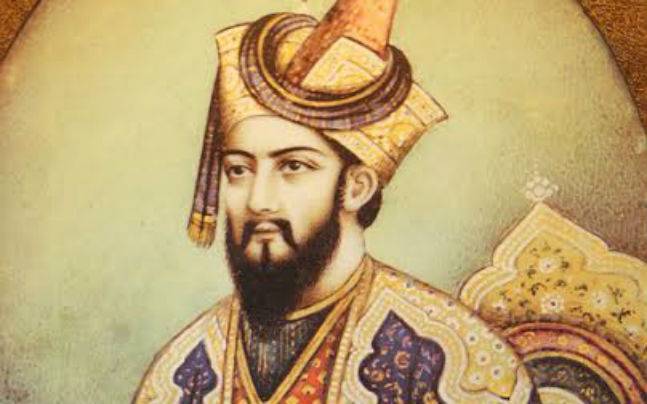
At first, he cleared his way by conquering Bajaur on the North-West boundary, Bhera and Punjab by conducting successive invasions during the period from 1519-1524 A.D. He then conquered Lahore and Deepalpur in 1524 A.D.
Daulat Khan Lodi and Akram Khan Lodi the main two rivals of Ibrahim Lodi requested Babur to attack Delhi. After that, he prepared to invade Hindusthan in 1525 A.D.
Sultan Ibrahim Lodi resisted Babur with 1,20,000 soldiers when Babur attacked Delhi in 1526 A.D. with 12,000 soldiers and some guns and cannons. As a result, a fearsome war was fought in the field of Panipath.
This is known as the 1st battle of Panipat (1526 A.D.) Sultan Ibrahim Lodi was killed in Panipath. Babur captured Delhi and Agra easily. But the existence of Rajputs and Afghan were still intact.
Historian Rushbrooke William thinks, “Panipath set his foot of the path of empire-building and in this path, the first great obstacle was the opposition of the Afghan tribes.”
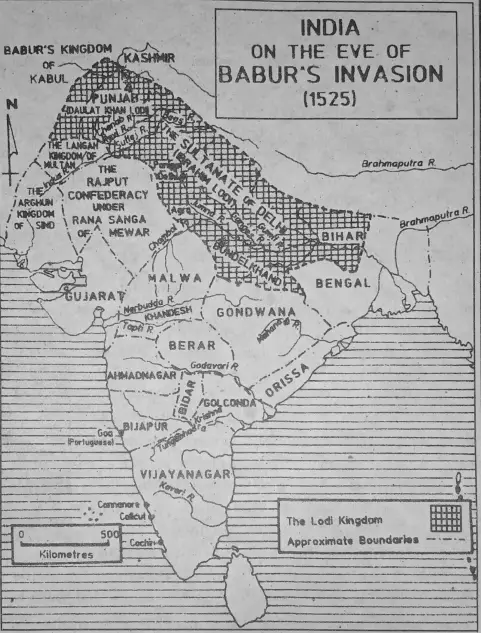
He got the title ‘Kalandar because he distributed the looted treasures among his soldiers, religious prophet and relatives. After that, he advanced towards Doab from Delhi. Babur sent his son Humayun to Kanauj to reduce the dominance of Lohani Afghan.
He himself advanced along with his Amirs towards Kalan, Biana and Cholapur to subdue the dominance of the Afghan leaders. But he was not completely successful.
“WBBSE Class 7 History Chapter 5 important questions and answers”
Historian Satish Chandra thinks that the battle of Panipat can not be called as ultimate from a political viewpoint. Because with this battle, Babur did not become absolutely enemy-free.
Rana Sanga or Sangram Singh, the winner of 18 battles, built a massive alliance to resist Babur for his building up the Mughal empire upon the ruins of the Sultanate empire.
The Rajput kings of Ajmer, Gwalior, Marwar, Ambar, Chanderi etc and Mahmud Lodi the brother of Ibrahim Lodi joined hands with Sangram Singh. On 17th March 1527 A.D.
Babur and Sangram Singh fought with each other continuously for ten hours in the field of Khanua. This is known as the battle of Khanua. In this war, Rana Sangram Singh was defeated and heavily injured.
Within a short time, the associates of Rana Sangram Singh murdered him with poison. Dr Rushbrooke William said, “The ratio of defeating rate between Rajput and Mughal was 7: 1”. But according to Dr A. L. Srivastava, the actual rate was 2: 1.
So Dr K. K. Dutta said, “The battle of Khanua is certainly on of the decisive battle of Indian history. In a sense, its results were more significant than those of the first battle of Panipat-” (An advanced History of India Page 429).
After the death of Sangram Singh Medini Ray of Malwa determined to stop the advancement of Babur, by unifying the Rajputs. Chanderi fort of Gwalior was the main gateway to Rajputana.
Babur defeated Medini Ray of Malwa and captured the Chanderi fort. After conquering Chanderi in 1528 A.D. he entrusted the ruling of Chanderi to the ex-ruler Ahmed Shah.
“Mughal Empire history Class 7 WBBSE chapter-wise explanation”
After conquering Chanderi, he marched towards Eastern India by conquering Allahabad, Gazipur and Varanasi. He was informed that Nasrat Shah of Bengal was giving shelter to the Afghans to accumulate power.
Babur diplomatically detached Nasrat Shah from the Afghans.” After that Babur defeated the Afghans by the side of the Gogra river on 6th May 1529 A.D. Sher Khan of Bihar and Mohammad Lodi of Jaunpur tried to unify all the leaders of Afghan against Babur.
As a result, Babur became enemy-free. The foundation of the Mughal empire became strong from Kabul to Gogra and from the Himalayas to Gwalior. Only after one year after this battle, Babur died at the age of 47 on 26th December 1530 A.D.
Babur gave Delhi the honour of being the capital city of the Mughal empire. He developed a common Indian mentality by the unification of Hindu and Muslim though he was a Sunni Muslim.
According to Dr R. S. Tripathi, ‘The seed of state policy of Akbar was sowed by his grandfather’. Dr R. S. Sharma said, “Babur introduced a royal dynasty and a state policy”.
But Rushbrook William thinks that Babur had left a spineless and structureless royal dynasty for his son. He did not have any administrative qualities.
According to Dr R. S., Tripathi Babur became famous as a commander and as a literator. He wrote his autobiography in the Persian language. Those are ‘Tuzuk-i-Baburi’ and ‘Baburnama’.
He also wrote poems in Persian and Turkey languages and introduced ‘Khat-i-Babur’ as a new form of the Turkey alphabet. According to the historian Mrs Annet Beveridge, “The autobiography of Babur is like those invaluable texts which are eternal and it is equally ranked with the books like confessions by saint Augustine and Russo and the memories of Gibon and Newton.
Chapter 5 The Mughal Empire Mughal Afghan Conflict from 1526 To 1556 A.D
The empire that was established by Babur in India was not free from the enemy. Because he could not eradicate the Afghan power permanently though he defeated them for several times. So, the Afghan power became powerful after the death of Babur.
The first three emperors of the Mughal dynasty, namely, Babur, Humayun and Akbar had to fight against Afghans. Akbar was able to diminish the Afghan power completely which had increased to a great extent in the first 20 years of the Mughal empire.
Emperor Babur defeated the Afghan power through the battle of first Panipath (1526 A.D.) and Gogra (1529 A.D.) but did not abolish the Afghans. Many Afghans helped Ibrahim Lodi in the first battle of Panipat.
But due to the defeat of Ibrahim, the Afghan power became weak. They became mentally upset. They continued some stray attacks on Babur though they were completely scattered.
Historian Rushbrook William said, “Panipath set his foot on the path of empire building and in this path, the first great obstacle was the opposition of the Afghan tribes.”
So, after conquering India, Babur instructed his subordinate Amirs to subdue the Afghans and establish peace in their respective areas. This policy clicked. Many Afghan leaders surrendered to Babur.
Then he deployed his son Humayun to control the Lohani Afghans on the East of Kanauj. Babur himself subdued the Afghans of Kalan, Biana and Cholapur with the help of his Amirs. Temporarily the Afghans became weak.
After the defeat of the Rajputs in the battle of Khanua, they became powerless. Because Afghans would have gained strength if the Mughals were defeated in the hands of the Rajput.
Apart from this, Babur foiled the attempt of Mahmud Lodi the brother of Ibrahim Lodi, in the battle of Gogra on the 6th May 1529 A.D. when Lodi tried to unify the Afghans of Bengal and Bihar against Babur.
In this time, Sher Khan of Bihar and Nasrat Khan of Bengal were against Babur. Though Humayun resisted the Afghans in the battle of Gogra, yet he was not free from this attack.
Chapter 5 The Mughal Empire Humayun 1530, 1545 To 1556 A.D
After the death of Babur his four sons, Humayun, Kamran, Askari and Hindal and a few relatives started disputing among themselves over the claim of the throne. Maham Sultana; the mother of Humayun permitted him to acquire the throne.
The word Humayun means ‘fortunate’. But he had many sleepless nights due to disturbances created by the Afghans and due to some internal troubles.
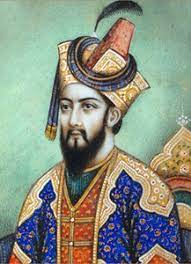
Due to such disorders in the Mughal Court, Bahadur Shah of Gujarat and Sher Khan of Bihar, two Afghan leaders advanced against Humayun to take revenge of the earlier defeats. All the rivals of Humayun helped the Afghans.
But due to his idiocy and in spite of the favourable situation, Humayun could not defeat Bahadur Shah and Sher Shah. But he had been able to keep king Prataprudra detached from the Afghans by capturing the Kalinjor fort.
Humayun only defeated Mahmud Lodi and his associates in the ‘Battle of Dadra’ in 1532 A.D. He could not subdue Sher Khan in spite of seizing the Chunar fort.
Sher Khan invaded Delhi and Agra and gave lot of trouble to Humayun when he was in Bengal. As a result, Humayun had to fight against Sher Khan in Chausa in 1539 A.D. and in spite of his large contingent of the army he lost that battle.
Afghan leader Sher Khan established his dominance over Kanauj, Jounpur, Bengal and Bihar. He took the title ‘Sher Shah’ to increase his own prestige and read ‘Khutba’ in his name.
The very next year, in 1540 A.D. Humayun again went to war against Sher Khan in the battle of Kanauj or Bilgram. But this time he lost the battle miserably and fled away with his wife to Persia.
As a result, Sher Shah re-established the Afghan empire in Delhi very easily. Before that he subdued the majority of his enemies in the Battle of Surajgarh in 1534 A.D.
But after reigning only for five years (1540-1545 A.D.) he was burnt to death in a fire that occurred in Kalinjor fort. After his death, his son Islam Shah became the king (1545-1554 A.D.)
Then the nephew of Sher Shah, Mohammad Adil Shah became the king after killing Firoz Shah, the son of Islam Shah. His Hindu commander-in-chief Hemchandra or Himu became all in all because Adil Shah – was inefficient and incapable.
By this time, Humayun returned to his home state. After his death, his son Akbar was brought up by Bairam Khan, a friend of his father. In 1556 A.D. Akbar. defeated.
Himu, the commander of Adil Shah and destroyed the hope of the Afghans to settle their rule forever. Akbar put an end of the Mughal-Afghan conflict which was continuing for the last 3 decades and set up a strong foundation of the Mughal empire.
Historian Dr Kali Kinkar Dutta has rightly said in his book ‘An Advanced history of India’ “The second battle of Panipat marked the real beginning of the Mughal empire in India and set it on the path of expansion.”
Chapter 5 The Mughal Empire Importance of 1st And 2nd Battle Of Panipat
The fates of many rulers of India were determined in the field of Panipath. From that viewpoint, Panipath is an important centre in Indian history. The 1st and 2nd battles of Panipat had a great impact on the rise of the Mughal empire.
The scene of the political history of India changed in the 1st battle (1526 A.D.) of Panipath during the time of Babur and the 2nd battle of Panipat (1556 A.D.) during the time of Akbar. These two battles were of much importance by overall judgement.
The First Battle of Panipat (1526 A.D.):
The 1st battle of Panipat was fought between Mughal leader Babur and the last Sultan of Delhi Ibrahim Lodi in 21st April 1526 A.D. In this battle, Babur had 12,000 soldiers and Ibrahim Lodi had 1,20,000 soldiers.
Class Vii History Book Wbbse
But the historian Rushbrooke William said that whatever might be the number of soldiers, Babur ultimately deployed 8,000 soldiers and Lodi deployed 40,000 soldiers in that battle.
Babur learnt the war tactics from the Uzbek and Turk leaders which was known as ‘Tulghuma’ tactics. Babur applied three tactics in the battle of Panipat.
These were
- Unique setting up of lines and forms.
- Effective use of cannons and guns and
- To attack with the fast-moving horses mounted by the Uzbek soldiers.
Applying such tactics, his artillery and cavalry division ended the war within half a day and defeated and killed Ibrahim Lodj. Just before the 1st battle of Panipat, Babur defeated Daulat Khan Lodi of Punjab.
Thus after the grand success in Panipath, his empire extended from Kabul to Delhi.
The Second Battle of Panipat:
The importance of the second battle of Panipat were
- The Afghan dynasty in India came to an end permanently.
- The effort of Himu for establishing a Hindu empire failed completely.
- The conflict between Mughals and Afghans, which was continuing for the last 3 decades in India, came to an end, after this 2nd battle of Panipat. Akbar became absolutely free from the fear of an Afghan attack when Mohammad Shah, the Sultan of Bengal killed Adil Shah Sur, the master of Himu.
- Akbar gained strength of mind and self-confidence with the conquest of the 2nd battle of Panipat. In a nutshell, it may be mentioned that the journey of victories, which started from the winning of this war, came to an end.
Chapter 5 The Mughal Empire Sher Shah 1540 To 1545 A.D
The Afghan hero Sher Shah (Farid Khan) was not only a good warrior but also was a great ruler. There was no other ruler found in mediaeval history other than Sher Shah who built such a modern and self-sufficient administrative system within a short span of time.
Being the son of an ordinary Jagirdar of Sasaram in Bihar, Sher Shah became famous for implementing a very good administrative policy. He became famous in history as a well-wisher of his people.
Class Vii History Book Wbbse
Sher Shah, as a ruler, showed nobleness, impartiality, judgement and welfare of the people in his five years reign (1540-1545 A.D.). It has become a rare example in history.
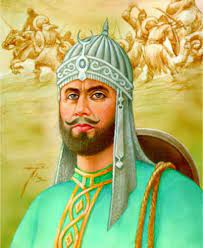
Historian William Erskine said, “He (Sher Shah) had more the spirit of a legislator and a guardian of his people than any prince before Akbar.” Sher Shah’s administration did not express any originality.
Because he followed the systems introduced by Alauddin Khalji. According to R. S. Tripathi and Dr Percival Spear, Sher Shah’s administration was partly a reform, and partly an innovation.
The entire system was based on an impartial rule formed on the unity of Hindus and Muslims and public welfare. Sher Shah was a powerful emperor, but he was not a despot. He used to rule with the help of his ministers.
These central ministers were Diwan-i-Wazirat (Chief Minister), Diwan-i-Araz (Revenue Minister), Diwan-i-Risalat (Counsellor), ‘And diwan-i-Insha (Army Minister). These four departments were helped by Diwan-i-Kazi (Chief Judge) and Diwan-i-Barid (Espionage).
“WBBSE Class 7 History Mughal Empire rulers and administration”
For better management of his administration, he decentralised his empire into 47 Shik or Sarkar. He employed one ‘Sikdar-i-Sikdaran’ (the man responsible for military and law and order) and one ‘Munsif-i-Munsifan’ (the man responsible for civil proceedings) in each region or Sarkar.
He divided each Sarkar into several Parganas. The responsible officers of these Parganas were Sikdar, Munsef, Amir, Kanungo, Karkoon, Khajanchi, Choudhury, Patwari etc. Each Pargana was further divided into villages.
The administration of the village was entrusted to the Panchayat. “The whole of his brief administration was based on the principle of Union.”
At first, the revenue minister of Sher Shah surveyed the entire land area and based on fertility divided all the cultivable lands into three parts-
- Extremely fertile,
- Fertile and
- Low fertility.
He fixed revenue at the rate ranging from rd to the 4th part depending upon the degree of fertility. The revenue (taxes) were paid either by money or by crops. The taxes were collected directly from the farmers.
Apart from land revenue, Mahasilana (money on account of tax for the tax collector), ‘Jaribana’ (tax money for the surveyors) and ceases tax (2 rupees per bigha were collected for giving subsidy during the feminine and epidemic).
The system of tax relief was there for in the case of natural calamity. The employee, who coerced the people for collecting taxes, was immediately discharged.
Sher Shah first recognised the right of people on land and registered the deed of land for each and every person. This title deed was known as ‘Patta’. Another deed was a government deed, known as ‘Kubliyat’ (Agreement deed).
In this deed, land tenants made an oath to pay taxes. Historian W. H. Moreland commented that the administrative system of Sher Shah was a modern system based upon the scientific base.
For the sake of commercial improvement, Sher Shah introduced the silver coin ‘Rupee’ and the copper coin ‘Dam’. He introduced gold coins also. He introduced new coins discarding the old alloy coins.
“Class 7 History Chapter 5 WBBSE The Mughal Empire detailed notes”
He withdrew all the internal duties for the development of inland trade and commerce, though the duties were levied for export and import trade.
There were 1,50,000 cavalry, 25,000 infantry and 5000 elephant cavalry in the central force of Sher Shah. Besides this, there was also an artillery division in his army.
At the time of recruitment, the soldiers had to undergo tests of capability and loyalty. Salaries were paid in cash instead of Jaigir. The system of transfer was also there. He introduced ‘Dag’ and ‘Hulia’ in his cavalry like Alauddin.
The powerful police force was also introduced to maintain law and order. There were employees named ‘Mahatasib’ who looked after the character and value sense of the public. The commander in chief was a Brahmin like Brahmajit Gaur.
The judicial system of Sher Shah was very strict and impartial. Kazi-ul-Kazatan (the main Kazi) is used to make a judgement according to Muslim law. Sikdar used to settle criminal cases.
The main responsible officer of this department was Mir-i-Adal. There, was Munsef to settle the cases relating to revenue. The judgements were impartial and strict. The accused persons were given a death sentence or caning according to the degree of crime.
Incidentally, it may be mentioned that Sher Shah himself was present to hear the appeals and settled the cases which were important. Many roads were built by Sher Shah. Among these the main roads from Agra to Jodhpur, Agra to Burhanpur, and Lahore to Multan were important.
The long road from Sonar Gaon (or Dhaka) to Thatta of Sind was known as ‘Sarak-i-Azam’ (or Grand Trunk Road) which is 1400 miles long. Historian Abbas Khan Sherwani said that he made 1700 saris beside the road.
There was a system of ‘Daroga-i-Dakchouki’. Through this, he introduced the system of postal communication on horseback. Apart from this, many spies helped Sher Shah in many ways. Sher Shah used to donate Rs. 18,25,000 each year.
The art lover Sher Shah built Rohtasgarh Fort, Purana Killa, Kila-i-Kuhna Mosque and his own tomb in Sasaram even before his death. He made the union of Indo-Persian art culture.
Chapter 5 The Mughal Empire Akbar 1556 To 1605 A.D
Akbar as a founder of the Empire:
Due to the invasion of Sher Shah, the defeated Humayun fled away to Sind and took shelter of Ranaprasad, the Hindu king of Amarkota. In this place, Hamida Banu, wife of Humayun gave birth to Akbar on 16th October 1542 A.D.
During this period, Akbar was passing through very bad days of misfortunes. Then, in 1551 A.D. Akbar became the ruler of Gazni with the help of his father Humayun. At that time, he was married to Rukia Begum.
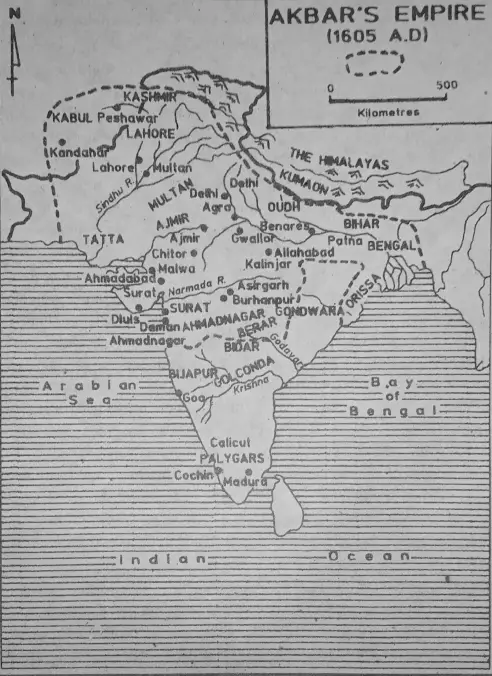
After that, he became the ruler of Punjab too. Akbar came back to Delhi after the death of Humayun on 27th January 1556 A.D. and being coronated by Bairam Khan, he acquired the throne of Delhi only at the age of 13 years and 4 months.
Historian Dr R. P. Tripathi thinks that Akbar was the first minor emperor whose emperorship was never challenged.
Conquest of state:
Akbar established an all-India base of the Mughal empire by winning a vast area of Northern and Southern India. The ‘Blood and Iron Policy’ in the field of winning the states brought him unhindered success in his life.
He first conquered the different states of Northern India and then advanced towards South India. Akbar, with the help of Bairam Khan, the guardian of his childhood, defeated the Hindu commander of Adil Shah, Himu in the 2nd battle of Panipat (1556 A.D.) and captured Delhi and Agra.
By taking the help of the guardianship of Bairam Khan, he conquered Ajmer, Jaunpur and Gwalior within 4 years (1556-1560 A.D.). Thus Akbar expanded his empire from Kabul to Jounpur and from Punjab to Ajmer and Gwalior.
In 1560 A.D. an Afghan leader murdered Bairam Khan when he was sent by Akbar to Mecca for Haj. Akbar married the widow of Bairam Khan, Selma Begum.
After the death of Bairam Khan, Maham Anaga, the foster mother of Akbar, and her son Adam Khan took over complete control of the harem. Dr V. A. Smith described the period from 1560-64 A.D. as a period of petticoat government.
From 1564 A.D. onwards, Akbar became the real ruler. Akbar sent his commander Adam Khan and Pir Mohammad (1560 A.D.) to subdue Baj Bahadur, the Afghan king of Malwa. Though defeated initially, Baj Bahadur regained Malwa again.
At last, Akbar sent his ‘commander Abdullah Khan Uzbek who defeated Baj Bahadur miserably in 1561 A.D. Actually Malwa became under the jurisdiction of Delhi in 1562 A.D.
Gandowana was a small state of Madhya Pradesh. Its capital was situated in Garh Katanga of Jabbalpur. Damo, Sagar, Mandala and Narmada valleys of Madhya Pradesh were under the Gandowana state. It was a prosperous state.
Queen Durgabati made his son Vir Narayan, the king after the death of the Rajput king Dalpat Shah. Being insulted, queen Durgabati committed suicide when the commander Asaf Khan, without the permission of Akbar, suddenly attacked Gandowana and killed Vir Narayan.
As a result, Akbar made Chandradhar Shah, the descendent of Dalpat Shah, the king of Gandowana and kept him under his control absolutely (1564 A.D.)
Without going into confrontation, wise Akbar set up a friendship with the Rajputs by marrying the Daughter of Bihari Mal, the king of Ambar (1562 A.D.) and later the princess of Bikaner (1570 A.D.).
Akbar also married his son Selim with the daughter of Bhagabandas of Bikaner (1584 A.D.). Bundi, Jodhpur and Jaipur also built up friendships with Akbar. But the Rana of Mewar, Uday Singh refused to establish any friendship with Akbar.
So Akbar along with his commander Asaf Khan fought continuously for four months and ultimately succeeded to capture the Chitore fort (Oct 1567 to February) 1568 A.D. In this time, the Rajput commander Jaimal died with the gunshot (Sangram) of Akbar.
Then, the other Rajput youths continued the battle under the leadership of Fatha desperately. But Akbar. entered the fort of Chitore and killed 30,000 dwellers of the fort brutally.
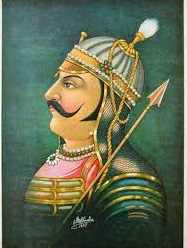
Many Rajput women performed Jahar Brata by sacrificing their lives in the fire. Uday Singh took shelter in Araballi hills. Akbar entrusted to Asaf Khan the administration of Mewar.
” After the fall of Chitore, Surjan Rai, the king of Ranthambore, realising that fighting with Akbar would be in vain, surrendered to Akbar in 1569 A.D. In 1569 A.D. the ruler of Kalinjor also surrendered to Akbar.
Thus, the prestige of Akbar increased by capturing Kalinjor and Ranthambore. In 1570 A.D. Hara Rai, the ruler of Jaisalmer married her daughter with Akbar and established a good relationship with each other.
Mewar became under the control of the Mughals when his commandant Mansingh defeated Rana Pratap Singh of Mewar in the battle of Haldighat in 1576 A.D.
Due to the worthlessness of Muzaffar Shah III, the Sultan of Gujarat, the selfish aristocratic class involved themselves in internal conflict. Right from the time of Humayun, the aristocratic class of Gujarat were showing their allegiance to the Mughals.
But during the time of Akbar, they refused to show such allegiance. Many aristocrats tried to make a conspiracy against him. The Mughal Wazir Itimad Khan wanted direct interference of Akbar when he failed to control the political unrest.
Akbar realised that Gujarat was a prosperous city. Through the ports of this area, different trade links were there with Western Asia and Europe.
So, without wasting time, he invaded Gujarat by travelling 450 miles in eleven days and captured Ahmedabad first and then Cambe valley. The Portuguese and other foreign merchants surrendered to Akbar.
In 1573 A.D. he completed the Gujarat expedition by conquering Surat. Dr V. A. Smith and Dr Omprakash think that due to the conquest of Gujarat, many seaports of the West came under the control of the Mughals. Akbar, before returning from Gujarat, made Mirza Aziz Koka the ruler of Gujarat.
The Afghan leader of Bengal Daud Khan Karrani, son of Suleman Karrani refused to surrender to the Mughals. As a result, Akbar sent his commandant Munim Khan in 1574 A.D. against Daud. But Daud Khan defended him in Patna.
Akbar again sent Munim Khan and Todarmal in 1575 A.D. They defeated Daud in the battle of Turkai or Turka in 1576 A.D. Daud Khan, with the permission of Munim Khan, returned to Bengal.
In the meantime, Munim Khan died of Malaria and Daud Khan again revolted. This time Akbar sent Muzaffar Khan Tubbati and Khan-i-Jahan to join Todarmal.
As a result, a large contingent of the Mughal army defeated Daud Khan in the battle of Rajmahal in 1576 A.D. and his converted commandant ‘Kalapahar’ was seriously injured. Todarmal then killed Daud.
Though Bengal and Bihar came under the emperorship of Mughals in 1576 A.D. yet many Hindu and Muslim Zamindars of Bengal like Chand Ray, Kedar Ray, Pratapaditya, Isha Khan; Musha Khan etc. revolted.
They are known as Barabhuiya of Bengal. Mansingh, the commandant of Akbar defeated them and established peace in Bengal. The conservative Ulemas of Kabul made a conspiracy against Akbar for making his cousin brother Mirza Mohammad Hakim the ruler of India.
Knowing this, Akbar subdued the Kabul revolt with the help of Rajput soldiers. After the death of Mohammad Hakim in 1585 A.D. Akbar sent his minister Birbal to Kabul. But he was killed by the Pathans.
At last, Akbar solved the problems of Kabul in 1586 A.D. and brought it under his emperorship. Akbar defeated Yusuf Shah in 1586 A.D. the ruler of Kashmir and conquered the Kashmir valley.
His commandant Abdur-Rahim Khan-i-Khanan defeated Mirza Fanibaig the ruler of Sind and captured Sind in 1592 A.D. The Mughal dominance was firmly established in the North-Western region of India with the conquest of Kandahar in 1596 A.D.
There was no religious interest behind the conquest of South India by Akbar. Only due to imperialism, he ventured to conquer South India.
The battalion of Akbar gained the Berar area by exécuting a treaty with Chandbibi, the local guardian of the minor Sultan of Ahmednagar in 1595 A.D. Akbar captured Ahmednagar after the death of Chand bibi in 1600 A.D.
In 1599 A.D. Akbar conquest the capital of Khandesh and the Asirgarh fort in 1601 A.D. The battle of Asirgarh (1601 A.D.) was the last battle of Akbar. He gained the Golconda fort by conquering Bijapur (1580 A.D.) and expelled the Portuguese of Goa.
Thus, Bijapur, Ahmednagar, Khandesh and Berar came under the Suba of Akbar. Dr. K. K. Dutta said, “Akbar’s Deccan policy was purely imperialistic in origin and outlook.”
Akbar established and extended his empire from Kabul in the North-Western region and Kandahar to Godabari in the South, from Brahmaputra in the East to the coastal area of Gujarat in the West. Historian Percival Spear said that he had absolute control over this vast empire.
Chapter 5 The Mughal Empire Mughal Rajput Relationship
Being a practical and wise ruler, Akbar realised within a short time that it would much more beneficial for him to establish friendly relations with the Rajputs instead of fighting with them.
He also realised that the security of the Mughal empire would definitely increase if a good friendship can be established with the brave Rajputs who were freedom-loving.
So Akbar wanted to register his supremacy and sovereignty indirectly either by a friendly relationship with the Rajputs or by a marital relationship. A historian has commented rightly on the policy of Akbar-“Rajputs should first be subdued and then conciliated.”
The Cause and Object of Akbar’s Rajput Policy:
Farsighted Akbar adopted a broad-based policy towards all Hindus and Rajputs and gave up the policies like oppression, disparity etc. There are some deep-rooted reasons behind these policies.
Firstly, the Hindus and Rajputs were the majority in India and without their help and cooperation, the administration would be difficult and the Mughal empire would not exist.
Secondly, the Mughals were immigrants in India. So their main enemy and rival was the Afghans of India. Though the Afghans became weak after the death of Sher Shah, yet, they were quite prominent in Bengal, Bihar and Malwa.
For this reason, the help of Rajput was absolutely necessary to subdue the Afghans. Thirdly, Akbar had doubt in his mind about the loyalty of the Mughal aristocrats.
Because, Bairam Khan, Shah Abdul Khan Mali, Adam Khan, Abdullah, Khan Uzbek, and the relative Mirza revolted against Akbar though initially, they were loyal to Akbar. For this reason, also, he relied upon the power of Rajputs.
Historian Iswariprasad has beautifully explained, “There could be no Indian empire without the Rajputs, no political or social synthesis (composition) without their intelligent and active co-operation.”
Different steps are taken for establishing a friendship with the Rajputs:
Akbar, for achieving his goal, took some positive steps to establish friendship with the Hindus, especially with the Rajputs. During the 350 years of Sultani rule in Delhi, different policies of disparity were taken against the Rajputs and the Hindus.
No Rajput personnel was engaged in any royal post. But Akbar, abolishing such a policy gave equal rights to the Hindus and Rajputs with the Muslim personnel.
It was an important event undoubtedly for this attitude of tolerance and coherence towards ‘the Rajputs. Akbar built up the security of his empire by establishing marital relationships. Akbar himself in 1562 A.D.
Married the eldest daughter of Bihari Mal, the king of Ambar (Jaipur) Jodhabai, whose son Selim married Manbai the daughter of Bhagawan Das, son of Bihari Mal in 1585 A.D.
Akbar recruited many Hindus and Rajputs, in his army, almost more than half. He used to appoint only Rajputs in high government posts. King Bhagawan Das and King Mansingh were appointed as chiefs of army staff.
Among other Rajputs and Hindus Todarmal and Birbal achieved high government posts. Akbar gave full religious independence to the Rajputs and Hindus. He gave open permission to Hindus to construct new temples, renovation of old temples, and to perform other religious rituals independently.
He did not destroy any idols or temples during his political expedition. Akbar used to attend physically Hindu ceremonies like Holi, Dewali, Dashera etc.
He had to be aggressive to Mewar, Ranthambore, and Kalinjor states though the majority of Rajput power like Jodhpur. Jaipur, Bikaner, Jaisalmer, Bundi etc. surrendered to him.
But after the battles were over, he gave special relief and advantage to those Rajput leaders who surrendered and showed loyalty to him. Though he was a Sunni Muslim at his early life, yet his religious broadness and religious tolerance brought a new dimension in the Mughal empire.
A sympathetic, noble, liberal-minded and righteous ruler like him is very rare. He made the ‘Sulh-i-Kul’ policy popular to abolish the disparity from the country of Dar-ul-Islam and ‘Dar-ul-Harb’. After the propagation of Din-i- Elahi, in 1582 A.D.
vegetarian diet, or monotheism, charities became part and parcel of his religious life. The orthodox religious rituals and the dominance of the priests were replaced by Akbar’s rational and logical religious activities.
Chapter 5 The Mughal Empire The administrative System Of Akbar
As a main maker of the Mughal administration, Akbar was the introducer of a broad-based, religiously impartial and welfare administration.
According to historian Jadunath Sarkar, Akbar had been able to combine Indian philosophy with Arabian and Persian philosophy. Dr Iswariprasad said that Akbar combined both the inland and the foreign rules with his own.
Accepting this statement, Razvi said, “The administration of Akbar was a mere imitation of Sher Shah’s”. But his administration appeared to be the best in the mediaeval age though it lacked innovative powers to some extent.
Central administration: Akbar was not wayward though he was an autocrat. He did not oppress the people. He always adopted the policy of people’s welfare. And for that reason, he used to take advice from his different central ministers for the sake of smooth ruling.
These ministers were
- Vakil-i-Mutlakh (Prime Minister)
- Diwan-i-Wazirat (Finance Minister)
- Mir Bakhsi (Defence Minister)
- Sadar-us-Sudur (Minister of Religion and Charity)
- Mir Saman (Home Minister)
- Muhtasib (Policy and Ideology)
- Kazi-ul-Kazat (Chief Justice).
There were also other officers to assist the central administration. Those are–Ariz-i-Mubarak, Mirbahari, Mir Araz, Mir Manzil, Mir Tozak, Mustafi, Daroga-i-Gusalkhana etc. Thus Akbar organised his central administration.
Regional administration:
According to Abul Fazal, Akbar divided his empire into 15 Subhas or states. Some also said that number of such Subhas was 12. Subhas were divided into some districts and districts were further divided into panchayats.
The important Subhas, that Akbar developed were Bengal, Bihar, Allahabad, Ayodhya, Agra, Lahore, Delhi, Malwa, Multan, Kabul, Kandahar, Gujarat, Ajmer etc. The ruler of the subha was called Subadar, Najim or Sipahsalar.
Subedar means Governor. There were officers like Diwan, Kazi, Bakhsi, Sadar and Wakinabish to help the Governor. Just like Sher Shah, he employed two classes of staff in every district. They were Fouzdar (Police) and Amal Guzar (Minister for land revenue).
“WBBSE Class 7 History Chapter 5 solved question paper”
There were employees named Fouzdar and Diwan in the district. There were employees like Patwari, Kanungo, Mukaddam, Matwal etc. in the village. Akbar used to communicate directly with the regional administration.

Judiciary:
Akbar used to be present personally in conducting the judiciary proceedings. ‘Kazi-ul-Kazat’ (the Chief Justice) gave his final judgement. Generally, the judgements were impartial and without any prejudice.
Besides the chief justice, there were also ‘Mir Adal’ and ‘Sadar-us-Sudur’ to assist him. Panchayets also performed judiciary proceedings in the villages. The proceedings were done in accordance with the Hindu and Muslim customs respectively.
Mansabdari system:
Akbar introduced the Mansabdari system in 1577 A.D. He introduced this system as a base of the military and civil judiciary systems. ‘So each Mansabdar used to keep soldiers and horses.
The word ‘Manṣab’ means the rank of the post. Mansabdari system was divided into 33 classes according to rank. The lowest masabu was 10 and the highest was 10,000 which increased to 12,000 in the period of Akbar.
Each Mansabdar had to maintain a fixed number of cavalry. For the reimbursement of these expenses, they were paid salaries in cash. In some cases, salaries were paid in the form of allotting land instead of cash.
Thus the Mansabdari system was replaced by the Jaigir system. The salaries and promotion retrenchments of the Mansabdars were dependent upon the emperor.
Chapter 5 The Mughal Empire Noorjahan
The meaning of the word ‘Noorjahan’ means the light of the world. The actual name of Noorjahan was ‘Meherunnisa’. Noorjahan was born in a desert near Kabul in 1578 A.D. Mirza Ghyas Beig, an aristocrat of Tehran was the father of Noorjahan.
But Ghyas Baig started a long march towards India with his children departing his motherland. He left behind his daughter near a tree because Noorjahan was born in his bad days.
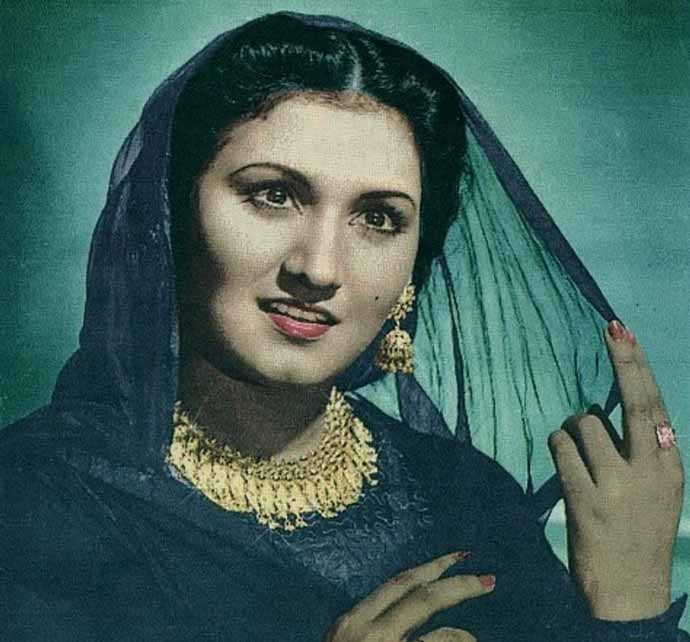
Shaik Mahmud, a religious man took Mirza Ghyas into the royal court of Akbar and provided him with a service. In the meantime prince Selim fell in love with young and beautiful Noorjahan and wanted to marry her.
But Akbar was against this proposal and gave the marriage of Noorjahan with the Afghan Fauzdar of Burdwan Alikuli Baig. After that Jahangir (Selim) became the emperor of Delhi and imprisoned Noorjahan in his harem for four years after killing Alikuli Baig in 1607 A.D.
He married Noorjahan in 1611 A.D. and gave her the honour of the prime queen ‘Mahishi’. He gave her the title ‘Noormahal’ or the light of the world. Later on she became famous as ‘Noorjahan’.)
Chapter 5 The Mughal Empire Jahangir 1605 To 1627 A.D
During the period from 1611 A.D. to 1627 A.D. the entire activity of Jahangir was conducted and supervised by Noorjahan. During this time, she promoted her father Mirza Ghyas Beig and her two brothers Asaf Khan and Itmad Khan to very high posts.
The vacuum which was caused by the weak administration of Jahangir was filled up by the skill and efficiency of Noorjahan. She became Padsha Begum by her own diligence.
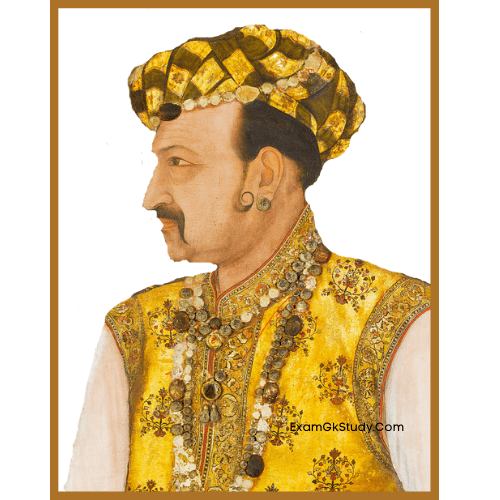
She proved her excellence in the fields of literature, art, politics, weaving, conducting wars on elephant back, hunting of tigers with her husband, archery etc.
Though she was very simple, kind and amiable in nature, yet she could understand the complicacies of politics very easily. According to Dr Iswariprasad, the impact of Noorjahan on Jahangir was uncanny and evil.
Dr Tripathi said that the influence of Noorjahan upon Jahangir was moral, emotional, psychological and probably Buddhist. Noorjahan took over the entire responsibility and charge when Jahangir became sick.
“Mughal Empire achievements and impact on India Class 7 WBBSE”
So it is called that she was not an evil power but a fortunate power. Towards the last phase, she constituted ‘Noorjahan ‘Chakra’ when she felt that the same conspiracies were being framed against her.
The constitution of this chakra was effective in her domestic cycle also. At last, her brother Asaf Khan and his son-in-law Khurram (Shah Jahan) dethroned Noorjahan and made Khurram the emperor of Delhi.
After departing from politics, Noorjahan lived for 18 years more. At this time, Shahjahan granted a yearly aid of Rs. 2 lacs to his stepmother Noorjahan. She died in 1645 A.D. and was buried beside the tomb of her husband Jahangir in Lahore.
Chapter 5 The Mughal Empire Baro Bhunya
During the reign of Jahangir, Islam Khan of Sipahasalar of Bengal first killed the Afghan leader Alikuli Baig and handed over his wife Meherunnisa to Jahangir. Then he took the initiative to subdue the 12 zamindars of Bengal.
There were both Hindu as well as Muslim zamindars among those 12. The meaning of the word Bhunya is a feudal king. Though it is called Baro Bhunya, yet there were many more zamindars in that group.
But main Bhunyas were
- Isha Khan and his son Musha Khan. They had zamindaris in Bagura, Pabna, Rangpur and Maymensingh.
- Pratapaditya. His father’s name was Srihari. They had their zamindaris in Jessore, Khulna and Bakharganj.
- Kedar Ray the son of Chand Ray was the zamindar of Bhusna.
- Usman Khan, the son of Afghan leader Katlu Khan was the zamindar of Srihatta.
- Raghunath was the zamindar of Susanga.
- Ramchandra was the zamindar of Bakla.
The majority of the Bhunyas were in the habit to oppress the people. Poet Rabindranath Tagore in his book ‘Bouthakuranir Hat’ had described the cruel and selfish nature of Pratapaditya.
The Bhunyas struggled for their existence against the Mughals and foreign powers. Pratapaditya fought and died in the battle of Khagraghat against the Mughals. We can know many things about the Bhunyas from the book ‘Baharisthan’.
Chapter 5 The Mughal Empire Shah Jahan 1627 To 1658 A.D
After the death of Jahangir, the fourth Mughal emperor, (28th October 1627 A.D.) his son Shah Jahan became the emperor. During his 30 years of rule, political peace, economic prosperity, literature, art and sculpture reached the apex.
This period is called the golden age in the history of the Mughals. Shah Jahan fulfilled with beauty the empire, which was founded by Babur and Akbar. Though Shah Jahan became the creator of the golden age simply by following the paths of his ancestors.
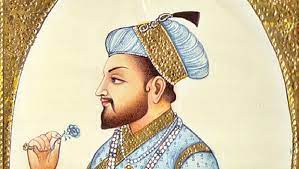
Akbar established political unity and his domination all over India. As a result, Shah Jahan did not face any difficulty in other political issues. He only could not recover the Kandahar state which was lost by the Mughals at one time.
Even then the political unity helped Shah Jahan to cultural advancement. Shah Jahan built Tajmahal by the side of the Yamuna river in loving memory of his beloved wife Mumtaj and he took advice from architects of different countries of the world.
Chapter 5 The Mughal Empire Aurangzeb 1658 To 1707 A.D
Historians have described the regime of Aurangzeb as a period of extreme expansion as well as a period of decline. Aurangzeb built up a very big empire by conquering a vast area. But at the same time, the number of revolts that happened was maximum in his time.
Aurangzeb was appointed Subedar in South India during the regime of Shah Jahan. He used to keep a sharp lookout towards South India after being the king in 1658 A.D. He spent the last 25 years (1682-1707 A.D.) out of his 50 years of rule in South India.
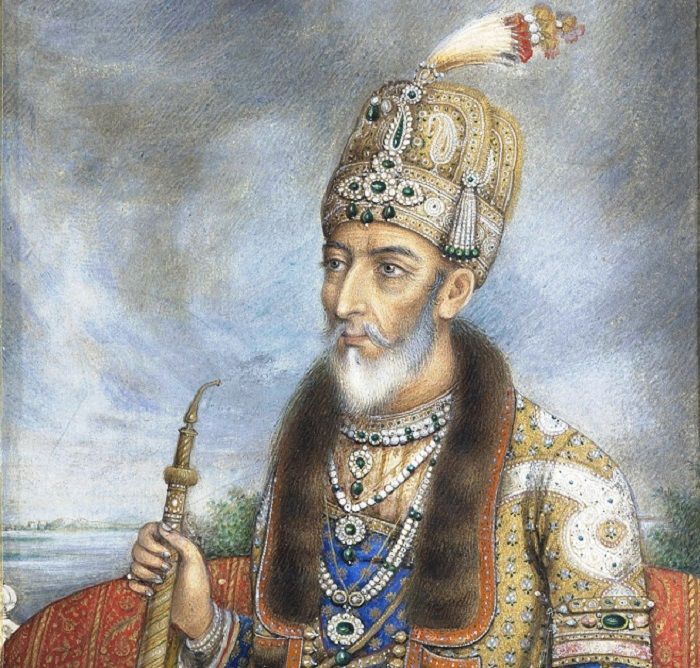
He stayed in South India for such a long time because of two reasons-
(1) To subdue Bijapur and Golconda the two shia states and
(2) To destroy the powerful Marathas.
Aurangzeb sent three expeditions in 1665, 1680 and 1682 A.D. headed by Jaisingh, Dilir Khan and Shahjada Azam. But all of them failed.
“WBBSE Class 7 The Mughal Empire mind map and key points”
At last, Aurangzeb invaded Bijapur state and in that occasion, Sikandar, the young ruler of the Shahi dynasty saluted him and surrendered. He promised to pay a subsidy of rupees one lac per year.
The tradition of the Shahi dynasty for 200 years which was founded by Yusuf Adil Shahi abolished completely on 12th September 1686 A.D. with the fall of Bijapur.
Abul Hasan the last sultan of the Qutabshahi dynasty of Golconda entrusted his empire to two Hindu ministers Akkana and Madana. He used to live in utmost comfort.
Marathas were in favour of Abul Hasan so Aurangzeb at first captured Hyderabad by his commander Shah Alam. At this time, the Mughals captured the Golconda fort by giving bribes to Mir Mohammad Ibrahim, the commander of Golconda.
Zabti system:
Akbar’s revenue minister Todarmal was also the revenue minister of Sher Shah. Todarmal used to determine the revenue by surveying the land in 1582 A.D. It was known as the ‘Zabti system’ in the Mughal period.
He introduced ‘Elahigaj’ for surveying land. Todarmal introduced three kinds of revenue systems. There were-Zabti or’Dahshala, Ghallabakhsi and Nasaq. Jabti system was in vogue in the entire North India.
According to this system, the land was divided into four groups.
(1) Polaz (Land for cultivation throughout the year).
(2) Parauti (The land which was kept uncultivated to make it fertile).
(3) Chachur (The land which remains idle for 3/4 years).
(4) Banzara (The land which remains idle for more than 5 years).
Ghallabakhsi system was in vogue in Kabul, Kandahar, Kashmir and Sindhu Pradesh in North- Western border of India. The Nasdaq system was in vogue in Gujarat and Bengal. Under this system, the land revenue were collected without surveying the lands.
“Mughal architecture and culture Class 7 History WBBSE”
Under all the system of land revenues, 1/3rd of the produced crops were collected as land revenue. These taxes were paid either in cash or by crops.
Apart from land revenue, there were ‘toll tax’, ‘water tax’, ‘building tax’, ‘trade duties’, ‘Nazarana’ and ‘Zarimana’ and in this process. The taxes were collected in the Treasury.
The main staff of the revenue department was Diwan (Revenue minister), Amin (Collecter), Bitikchi (Revenue accountant), Patwari (Local staff) Mukaddam Sadar (Principal officer for charity and religion) etc.
